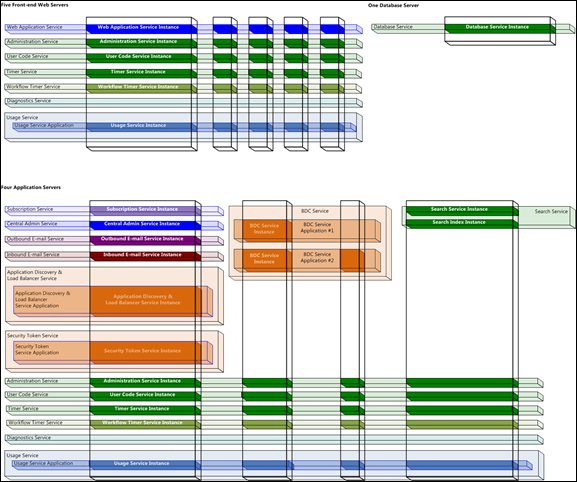Services Running in a Multi-Server SharePoint Farm
This graphic shows the services, CFSIs (configured farm-scoped instantiations), and service instances on a hypothetical 10-server farm. Note the following things about this example:
The translucent rectangles represent services. These services are modeled in the SharePoint Foundation object model with SP*Service classes.
The darker translucent rectangles represent CFSIs ("service applications") that are modeled in the SharePoint Foundation object model with SP*ServiceApplication classes.
The smaller, solid rectangles represent instances of services that are modeled in the SharePoint Foundation object model with SP*ServiceInstance classes.
The Diagnostics Service has instances running on all servers (except the dedicated database server), but the object model has no SPDiagnosticServiceInstance class (because there is no need for one in SharePoint Foundation), so there are no sold rectangles for these instances.
The Administration, Timer, Workflow Timer, User Code, Diagnostics, and Usage services run on all servers (as they must), except the dedicated database server.
Only the five front-end Web servers run the Web Application Service.
There is a dedicated search server.
There are two dedicated Business Data Connectivity (BDC) servers.
The BDC service has two CFSIs (service applications). One has an instance on each of the dedicated BDC servers, but the other is running on just one of them. The front-end Web servers must have separate service application proxies targeting these two different CFSIs.
A fourth, multipurpose application server runs Central Administration, the e-mail services, the subscription service, the security token service, and the application discovery and load balancer service. Since the Central Administration Web service hosts a Central Administration Web application, this server would also have service application proxies running on it if it needed to consume any of the services that implement the Service Application Framework. This is an exception to the usual principle that consumer proxies in the framework run on front-end Web servers.
When the SharePoint Foundation databases are on a dedicated server, as in this case, SharePoint Foundation need not be installed on that server. The Database Service is just a wrapper for the SQL Server service running on the database server. Hence, SharePoint Foundation code is not running on the dedicated database server. The service and its instance appears in the figure because it is represented in the object model with the SPDatabaseService and SPDatabaseServiceInstance classes.
For more information see Background: Service Entities in Microsoft SharePoint Foundation
